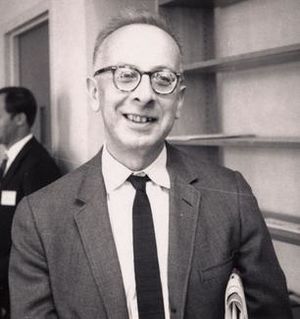Max Black facts for kids
Quick facts for kids
Max Black
|
|
|---|---|
 |
|
| Born | February 24, 1909 |
| Died | August 27, 1988 (aged 79) |
| Nationality | British American |
| Alma mater | Queens' College, Cambridge |
|
Notable work
|
The Identity of Indiscernibles |
| Era | 20th-century philosophy |
| Region | Western philosophy |
| School | Analytic philosophy |
| Institutions | Institute of Education University of Illinois Cornell University |
|
Main interests
|
Philosophy of language Philosophy of mathematics Philosophy of science Philosophy of art |
|
Notable ideas
|
Criticism of Leibniz' law |
|
Influences
|
|
|
Influenced
|
|
Max Black (born February 24, 1909 – died August 27, 1988) was an important British-American philosopher. He was a leading thinker in a field called analytic philosophy after World War II.
Max Black wrote a lot about how we use language. He also explored the ideas behind math and science. He even wrote about the philosophy of art. He also studied the works of other famous philosophers like Frege. Max Black helped translate Frege's writings, which became a very important book.
Contents
Max Black's Life and Work
Max Black was born in Baku, which is now in Azerbaijan. His family was Jewish. They moved to London in 1912, where he grew up.
Early Life and Education
Max Black studied mathematics at Queens' College, Cambridge University. There, he became very interested in the ideas behind mathematics. Many famous philosophers were at Cambridge at that time. These included Russell, Wittgenstein, G. E. Moore, and Ramsey. Their ideas likely had a big impact on young Max.
He finished his studies in 1930. Then, he received a special award to study in Göttingen, Germany, for a year.
Teaching and First Book
From 1931 to 1936, Max Black taught mathematics. He worked at the Royal Grammar School, Newcastle.
His first book came out in 1933. It was called The Nature of Mathematics. This book explained complex ideas from a famous math book called Principia Mathematica. It also talked about new ideas in the philosophy of mathematics.
Moving to the United States
Max Black taught math at the Institute of Education in London from 1936 to 1940. In 1940, he moved to the United States. He joined the Philosophy Department at the University of Illinois.
In 1946, he became a professor of philosophy at Cornell University. Two years later, in 1948, he became a citizen of the United States.
Important Ideas and Recognition
Max Black made important contributions to the idea of identity. He challenged a famous idea called Leibniz' Law. This law suggests that if two things have exactly the same properties, they must be the same thing.
In his essay "The Identity of Indiscernibles," Black imagined a situation. He thought of two identical spheres in an empty space. Even if they had all the same properties, they would still be two separate spheres. This idea showed a problem with Leibniz's law. It meant that just because two things look exactly alike, they are not necessarily the same thing.
Max Black was elected a Fellow of the American Academy of Arts and Sciences in 1963. He passed away in Ithaca, New York, when he was 79 years old. His younger brother, Sir Misha Black, was a well-known architect.
See also
 In Spanish: Max Black para niños
In Spanish: Max Black para niños

